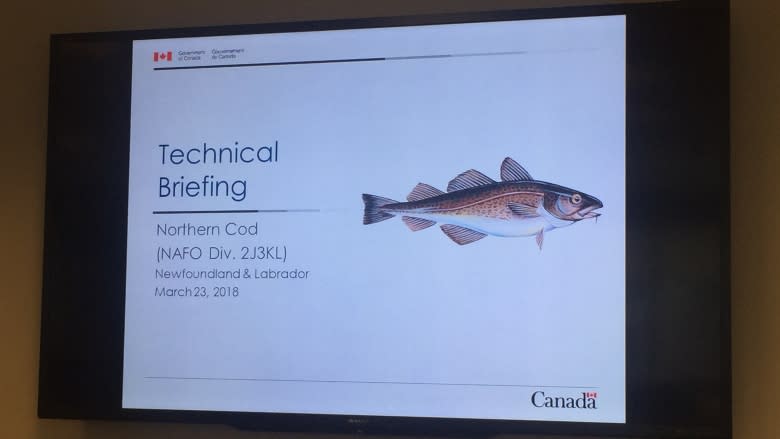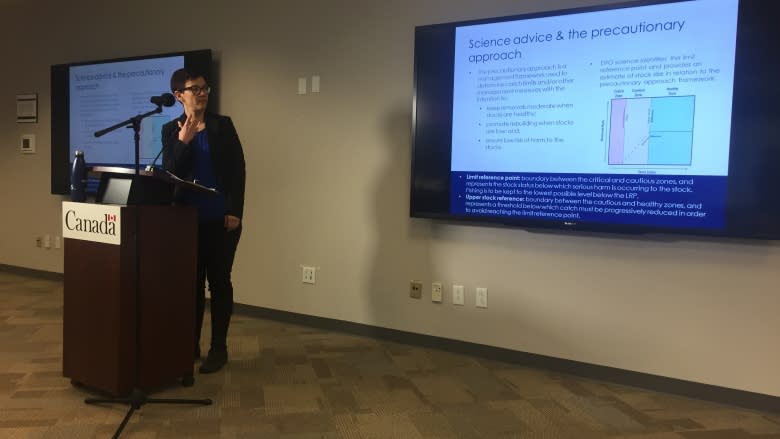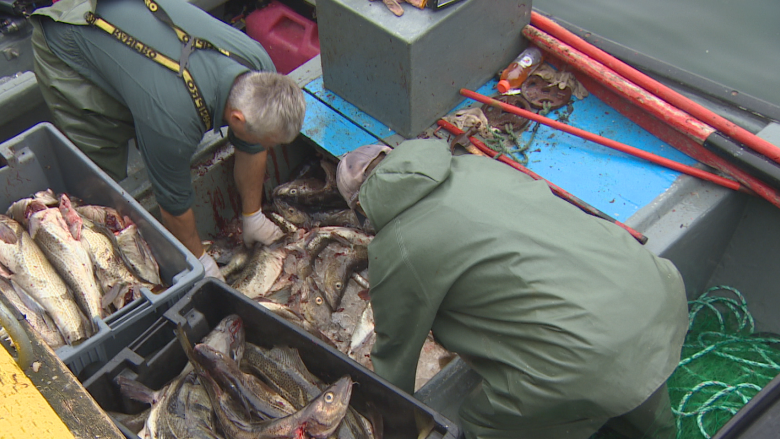Northern cod stock down by 30%, still in 'critical zone'
The latest cod stock survey by the federal Department of Fisheries and Oceans (DFO) shows that the small improvement reported in recent years is already on the decline.
Cod stocks had been showing improvement since 2012, but according to a stock assessment released Friday, the stock declined by 30 per cent in 2017 to 315,000 tonnes.
According to the federal department, one of the biggest reasons for that decline is the natural mortality rate, and it projects a high probability of continued decline into next year.
"These large increases in natural mortality can happen, and they're very hard to predict," said Karen Dwyer, a DFO scientist.
"We do have external evidence that says that maybe there isn't a lot of capelin and shrimp, which are food sources for cod."
The stocks had been expected to increase this year, but Dwyer said projections are not guarantees.
"It was projected to increase this year, but if something changes from year to year your projections are not going to bear out. And that's what happened in this case."
Still in the 'critical zone'
When asked about the return of the commercial cod fishery, Dwyer said it's a waiting game.
"We're still in the critical zone. We're seeing improvements in some areas and maybe not such improvements in other areas. I don't have any timelines," she said.
In addition to the increase in natural mortality rate, fishing mortality rate has also increased gradually every year since 2015.
"This is a reminder that where we are in that critical zone, it's a very precarious place to be. We have to be careful with all sources of removal," Dwyer said.
Keeping quotas as low as possible is the recommendation from scientists.
No need for panic
The union that represents fish harvesters in Newfoundland and Labrador is taking a cautious approach to the stock assessment numbers.
"While this news is not what fish harvesters had hoped for, these types of fluctuations are to be expected in any species that is recovering and is certainly not a cause for panic," said FFAW-Unifor President Keith Sullivan in a news release.
The stock is still healthier than it was in 2005, he said, when it was at 25,000 tonnes
Sullivan said the union would like more research done on the impact of predators such as grey and harp seals, and a bigger cull of the seals.
Tracking the amount of cod taken in the recreational fishery is also crucial, he said.
Sullivan also took a swipe at the offshore fleet, which he said continues to operate draggers in the "vulnerable" 3PS area.
"Clearly, we are concerned," said Derek Butler, head of the Association of Seafood Processors. "It is not the news the industry had hoped for."
Butler said processors will be reviewing the assessment, and its ramifications, in advance of DFO consultations planned for mid-April.
The World Wildlife Fund, in a statement Friday afternoon, called the stock assessment "a significant setback" and blamed the decline, in part, on a changing climate and ecosystem.
"This means we need to think differently about how cod is managed, including taking into account cod's main food source, capelin," said Sigrid Kuehnemund, vice president of ocean conservation for WWF Canada.
Critics question quota increases
One of those is Sherrylynn Rowe, a biologist at the Marine Institute at Memorial University in St John's.
"I think a lot of questions will be asked in the days and weeks to come about whether this was the right decision," Rowe said.
"But my position is that given the changes that we've seen in the stock at present and projected decline moving forward, a continuation of the present approach and associated removals stands to jeopardize the long-term stock recovery and having a rebuilt fishery."
Kris Vascatto of the Groundfish Enterprise Allocation Council, which represents large offshore companies, is another that warned the comeback projections were overly rosy.
"In 2016, the stock was expected to grow, through indicators, by 22 per cent. We only realized seven per cent growth. At the same time, we saw very poor conditions, lowered growth estimates and we saw continued ecosystems concerns," Vascatto said.
The quota increases since 2015 were irresponsible, he said.
"I view it as a stain on fisheries management. That we've seen increases of catch that far outstripped the growth in the stock at the same time we are looking at a fishery that rivals any other groundfish fishery in Atlantic Canada in terms of overall landings."
Minister responds
Provincial Fisheries Minister Gerry Byrne disputed that view.
"We are a government that follows the advice of science, of evidence, we are a conservation minded government, and we are responding positively to science," he said.
He said the changes to the quotas had no effect on the substantial drop in cod stock.
"Last year there were just over 12,000 metric tonnes of removals. This year in one year alone, they're now indicating the spawning biomass is down by over 100,000," said Byrne.
Bryne believes more research needs to be done into what's causing those natural mortalities and how this 30 per cent reduction happened in just one year.










